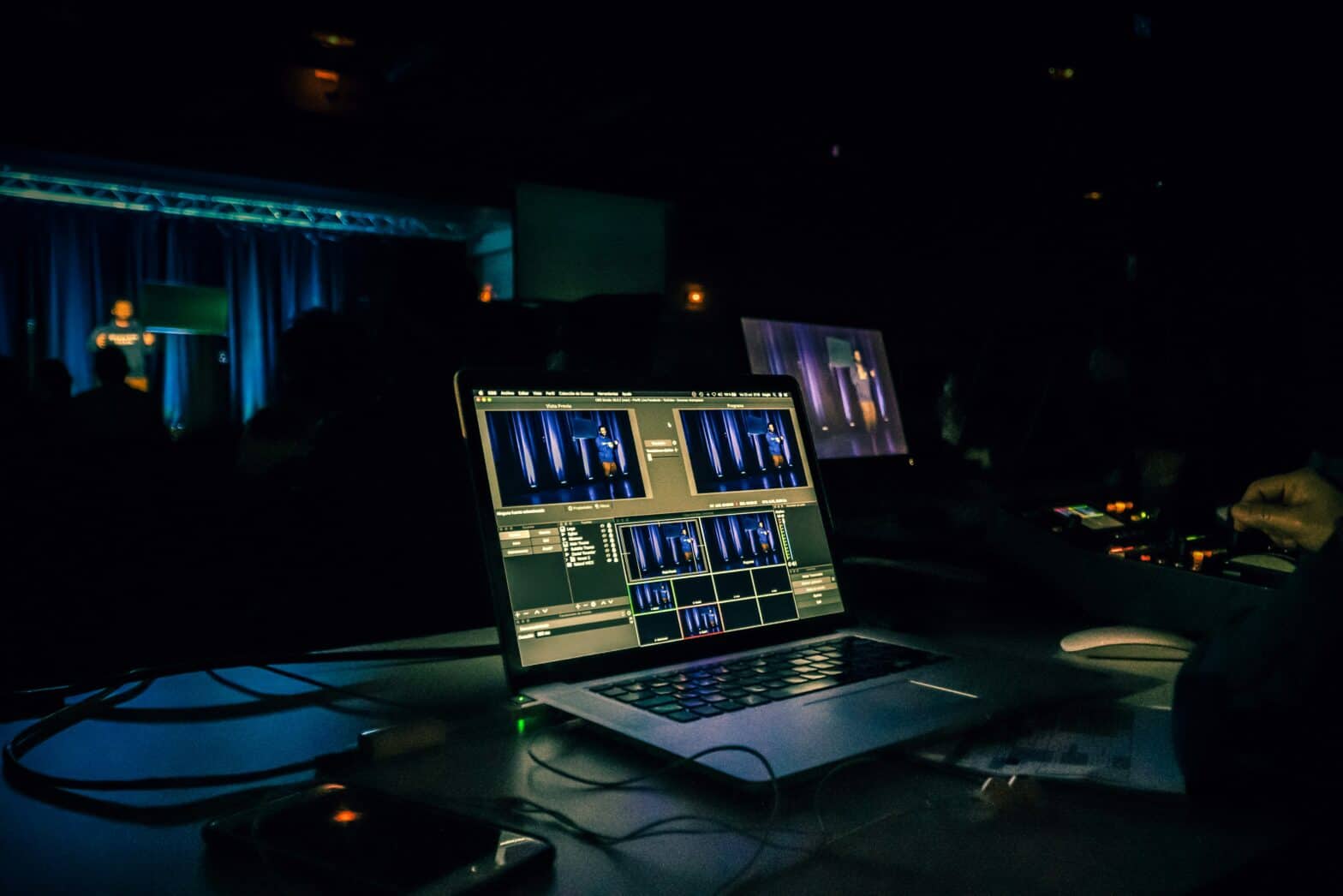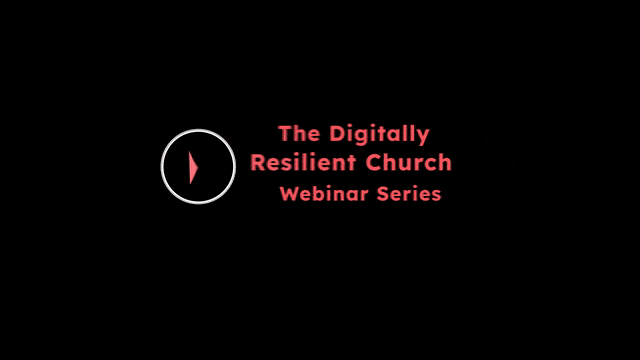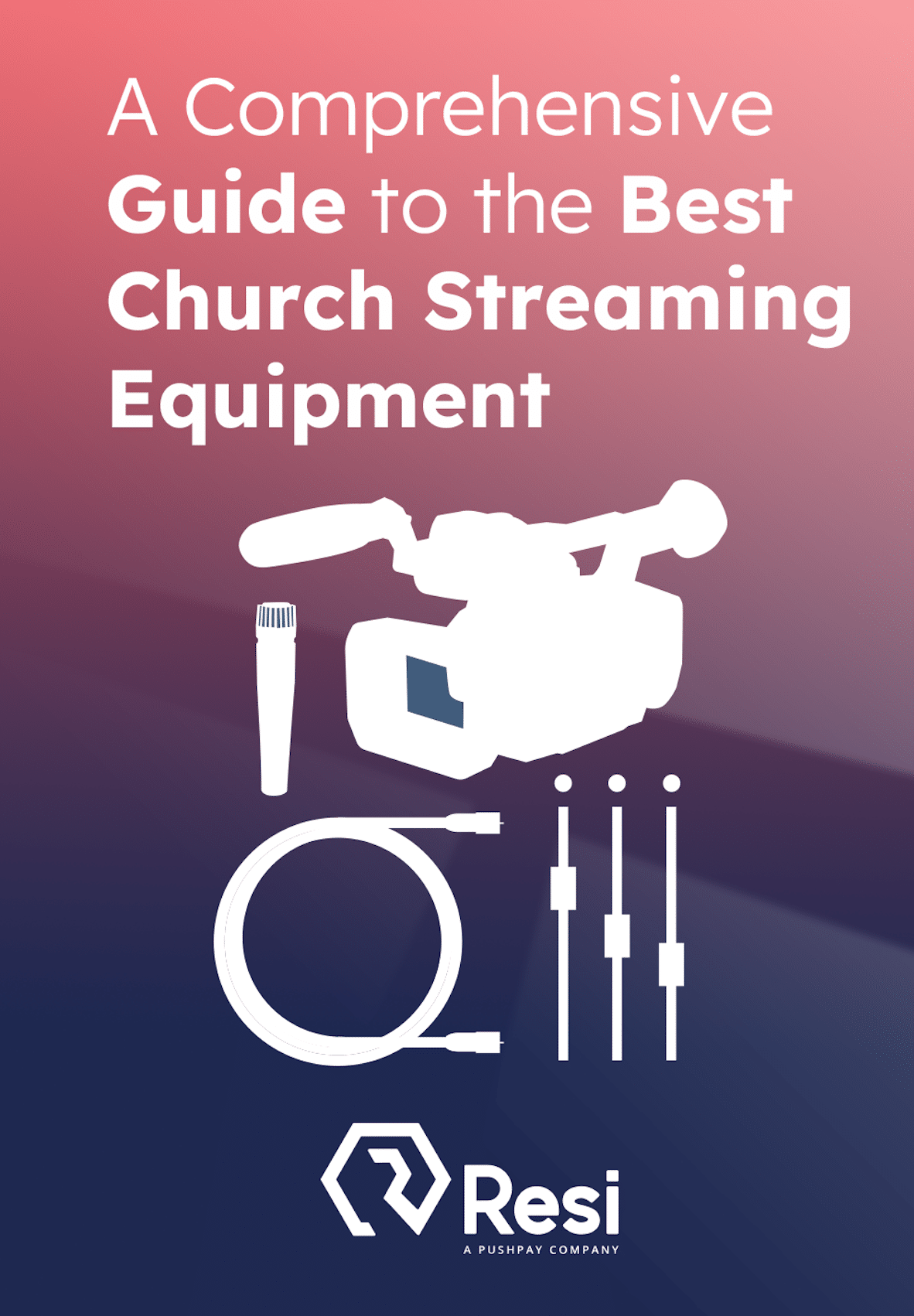
You’ve seen the analytics. Your online attendance is growing, but viewer retention tells a different story—people are dropping off halfway through. Or maybe it’s the volunteers who are burning out, spending more time troubleshooting than actually serving. Perhaps it’s the executive pastor asking (again) why the stream quality doesn’t match what people see on Netflix.
The temptation is to blame the equipment you have or assume you need to replace everything. But here’s what veteran tech directors know: the gap between “streaming that works” and “streaming that works flawlessly” usually comes down to three specific upgrades. Not ten. Not a complete overhaul. Three targeted changes that solve the problems costing you viewers, volunteers, and peace of mind.
The Real Cost of Streaming Technology
Before diving into specific upgrades, let’s address the elephant in the budget meeting: ROI anxiety. Church tech directors and executive pastors need to justify every dollar spent, especially when multiple departments are competing for limited resources.
But “worth it” means something different in live streaming than it does for other ministry investments. The right live streaming technology doesn’t just incrementally improve your video quality—it fundamentally changes what’s possible for your team and your online congregation.
A worthwhile upgrade reduces volunteer frustration and turnover. It eliminates stream failures during baptisms, Easter services, and guest speaker events. It improves viewer retention so your message actually reaches the people tuning in from home. It simplifies workflows so your team can focus on ministry instead of troubleshooting codec settings at 9:45 on Sunday morning.
Most importantly, the right technology scales with growth. You don’t want to invest in church streaming equipment that barely handles today’s needs, only to replace it in 18 months when you add a second campus or your online attendance doubles.
The three upgrades below deliver disproportionate returns because they address the core challenges that plague most streaming setups—reliability, quality, and operational complexity.
Why Your Computer Isn’t Cutting It Anymore
The Problem with Software-Only Solutions
Software encoders work. Let’s start there. For many churches, a laptop running OBS or similar software is how they started streaming, and it got the job done. Budget-friendly, flexible, and familiar to volunteers who’ve used video editing software before.
But when the stakes are high—weekly services with hundreds of online viewers, special events that only happen once, moments you can’t redo—dedicated hardware makes the difference between “mostly reliable” and “bulletproof.”
The issue isn’t that software encoders are bad. It’s that they’re asking a computer to do too many things at once. Your production laptop is encoding HD video, running presentation software, maybe handling audio mixing, definitely running background processes you didn’t authorize. When someone opens Chrome in the production room or a Windows update decides now is the perfect time to install, your stream pays the price.
What Hardware Encoders Actually Do
Think of a hardware encoder as a specialist rather than a generalist. It’s a dedicated device built for one purpose: encoding video without competing for resources or getting distracted by other tasks.
There’s no underlying operating system to crash. No software updates causing surprises. No memory leaks from browsers you forgot to close. Just professional-grade compression that preserves quality while optimizing bandwidth, running on hardware designed specifically for the job.
Hardware encoders handle H.264 compression natively—the same standard Netflix uses. They can push full HD (or even 4K) content over standard internet connections that would choke a software solution. And they include redundancy features that software simply can’t match, like automatic reconnection if your internet hiccups or local recording backup if everything else fails.
Real-World Impact
Here’s what actually changes when you upgrade to dedicated hardware:
Your streams don’t drop when someone opens Spotify in the production room. Quality stays consistent week after week, not “great when nothing else is running” and “choppy when the building WiFi is busy.” Volunteers can operate the encoder without understanding bitrate calculations or troubleshooting driver conflicts.
And during high-attendance events—Christmas Eve, Easter, anything that brings extra devices onto your network—performance doesn’t degrade. The encoder has reserved bandwidth and processing power. It’s not making compromises or hoping for the best.
Churches using hardware encoders report something else: confidence. The tech director breathes easier. Volunteers don’t dread their serving schedule. Pastors stop checking their phone during sermons to make sure the stream is still running.
That’s worth more than any spec sheet can quantify.
The Buffering Problem Nobody Talks About
Why Viewers Abandon Your Stream
Here’s a stat that should concern anyone responsible for online worship: 27% of viewers abandon a stream after the first buffering wheel appears. 40% leave after the second.
Read that again. Nearly half your online congregation will leave if they experience two interruptions. The sermon content doesn’t matter. The worship quality doesn’t matter. The production value doesn’t matter. If the stream buffers twice, they’re gone.
Traditional streaming technology assumes perfect internet. It sends data packets and hopes they arrive instantly and in order. When they don’t—and on real-world church internet, they often don’t—your viewers see stuttering, freezing, or that spinning wheel of death.
This is especially brutal for churches in older buildings with infrastructure that wasn’t designed for streaming. Or churches sharing bandwidth across multiple services, kids’ check-in systems, security cameras, and staff devices. Your message might be flawless in the sanctuary, but online viewers are getting a choppy, frustrating experience that makes them tune out.
How Resilient Streaming Changes Everything
Resilient streaming technology takes a fundamentally different approach. Instead of demanding perfect internet and punishing viewers when it’s not, it uses a strategic delay to ensure 100% perfect content reaches your audience.
Think of it like this: traditional streaming is like someone reading you a book over a bad phone connection. Every time the line cuts out, you miss words. Resilient streaming records the book, then plays it back over the line—if the connection drops briefly, it just picks up where it left off. No missing words. No interruption to your experience.
The technical term is Resilient Streaming Protocol, and it changes what “reliable” means. Your internet can drop for up to 90 seconds, and viewers won’t notice. Network hiccups from building-wide WiFi usage don’t cause stream drops. You can confidently stream from locations with less-than-ideal internet—retreat centers, outdoor events, temporary setups—knowing your viewers will get smooth playback.
What This Looks Like in Practice
A church in Oklahoma had their internet go down for 16 minutes during a service. Sixteen minutes. Their entire connection dropped. But their live streaming platform kept buffering the content locally, and when connectivity returned, it resumed transmission without viewers seeing any interruption.
That’s not luck. That’s architecture designed for real-world conditions instead of ideal lab conditions.
For tech directors, this means no more apologizing in the chat for “technical difficulties.” No more restarting streams and hoping it works this time.
Beyond basic resilience, modern platforms add adaptive bitrate streaming and cloud transcoding. If a viewer has slower internet, the platform automatically serves them a lower bitrate version without affecting anyone else. All the heavy processing happens in the cloud, saving bandwidth at your physical location.
The result: streaming that just works, regardless of what else is happening on your network or what devices your viewers are using.
Reaching People Where They Are
The Multi-Platform Reality
Your congregation isn’t on just one platform. Some prefer Facebook because that’s where they already spend time. Others default to YouTube because the app is on their TV. Your church website needs a native feed for people who don’t use social media. And maybe you’re streaming to a partner church across town or an overflow room in your own building.
Managing multiple streams manually creates unnecessary complexity. Different platforms have different encoder requirements. Different streaming keys to manage. Different dashboards to monitor. If something goes wrong, you’re troubleshooting multiple systems while trying to keep the service running.
More importantly, manual multi-platform streaming creates opportunities for error. Forgot to update the YouTube stream key after testing last week? Half your viewers just saw a “stream offline” message. Copy-pasted the Facebook URL into the wrong field? Your website embed isn’t working. These aren’t hypothetical problems—they’re weekly reality for churches trying to maintain presence across multiple platforms.
Automation That Actually Saves Time
Modern live streaming technology handles multi-destination streaming from a single source. You set up your destinations once—Facebook, YouTube, your website, RTMP endpoints for other services—and the platform distributes your content automatically.
This isn’t just convenient. It’s operationally transformative. Your volunteers focus on one encoder and one dashboard. When you schedule a pre-recorded video for Christmas Eve or a sermon replay for midweek study, it goes live everywhere simultaneously. You’re not juggling multiple interfaces or hoping you remembered to start all the streams.
The technical heavy lifting happens in the cloud. Your local hardware sends one stream to the platform, which handles transcoding and distribution to all destinations. This means your internet bandwidth isn’t multiplied by the number of platforms you’re streaming to. It also means platform-specific encoding requirements are handled automatically—you’re not optimizing settings for each destination or dealing with Facebook’s different specs than YouTube’s different specs than your website player’s.
Churches report saving hours per week on stream management. More importantly, they report reducing errors and reducing the skill level required to operate the system. When a new volunteer joins the team, they’re learning one workflow, not five platform-specific processes.
Beyond Social Media: Multisite Streaming
For larger churches or multi-campus ministries, streaming between physical locations is its own category of complexity. You need reliable video transmission over public internet connections—often to buildings you don’t control and can’t upgrade.
Traditional solutions require expensive dedicated circuits or enterprise networking that’s beyond most church budgets. Or they accept unreliable performance and plan around it (recording services locally and playing them back later, losing the “live” experience entirely).
Multisite streaming built on resilient protocols changes the economics. You can stream between campuses over regular internet, with playback reliability that matches or exceeds what you’d get from cable or satellite distribution. Receiving sites use volunteer-friendly decoders that “just work”—plug them in, connect to the internet, and they automatically pull the feed.
Advanced setups can include multiple audio channels for translations, cues, or click tracks. Your main campus sends 16 channels of audio alongside video, allowing receiving sites to mix locally or provide Spanish translation without affecting the primary audio feed.
This level of capability used to require broadcast engineering expertise and equipment budgets measured in tens of thousands. Now it’s accessible to churches of any size, with technology that scales from one campus to many without exponential cost increases.
Start Where It Hurts Most
Not every church needs all three upgrades immediately, and trying to implement everything at once can overwhelm teams and budgets. Better to prioritize based on your biggest current pain point.
If your primary problem is reliability—streams dropping mid-sermon, volunteers constantly troubleshooting, anxiety about whether the stream will make it through this week—start with a hardware encoder and resilient streaming platform. These two upgrades work together to eliminate 90% of “stream went down” emergencies. You’ll see results immediately: fewer failures, less stress, more confidence that your message is reaching online viewers reliably.
If your primary problem is time and complexity—volunteers spending hours managing streams across multiple platforms, constant training required for new team members, manual processes that create opportunities for human error—prioritize multi-destination automation. This upgrade saves the most operational overhead and dramatically reduces training requirements. You’ll free up time currently spent on stream management and redirect it toward production quality or ministry impact.
If your primary problem is quality and engagement—viewers complaining about buffering, analytics showing high drop-off rates, comparisons to professional streaming quality—focus on better encoding combined with resilient delivery. The combination ensures viewers get the experience your content deserves, without interruptions or quality degradation. You’ll see improvements in watch time and viewer satisfaction metrics.
The Compound Effect
These upgrades don’t exist in isolation. They build on each other.
Better encoding feeds better distribution. There’s no point automating delivery to six platforms if the source quality is inconsistent. Conversely, pristine encoding doesn’t matter if your distribution method can’t reliably deliver it to viewers.
Reliable streams enable confidence in multisite deployments. You can’t expand to multiple campuses if your streaming isn’t bulletproof. But once you have that reliability foundation, multisite becomes operationally viable rather than technically risky.
Automation frees up capacity to focus on production quality. When your volunteers aren’t troubleshooting encoders or managing multiple platform dashboards, they can pay attention to lighting, audio mixing, and camera work. The result is better overall production, not just more reliable streaming.
Think of it as building a foundation, then building capability on that foundation. Churches that try to skip steps—automating unreliable streams, or distributing poor-quality video efficiently—end up frustrated. But churches that layer these upgrades strategically see compounding returns. Each improvement makes the others more valuable.
Investing in the right live streaming technology isn’t about having the fanciest setup in your denomination. It’s about removing barriers between your message and the people who need to hear it. When someone tunes in from a hospital bed, a college dorm, or their living room because they can’t make it to the building—they deserve the same quality experience as someone sitting in the sanctuary.
Building a Streaming Setup That Scales
The best time to think about your streaming setup’s future is before you’re constrained by its limitations.
Start with an honest audit of your current system. Where do failures happen most often? Is it encoding, where your computer-based solution crashes under load? Is it distribution, where you’re losing viewers to buffering? Is it operational complexity, where volunteers are overwhelmed by the number of steps required to go live?
Talk to your team about what causes the most stress or consumes the most time. The answer might surprise you. Sometimes the technical problems that seem urgent (like “we need better cameras”) matter less than operational problems that drain energy (like “we spend an hour every week troubleshooting the stream setup”).
Consider not just today’s needs but where you’ll be in two years. Online attendance that’s 50 people today might be 200 next year. One campus might become three. A volunteer team that’s tech-savvy might experience turnover and suddenly need simpler tools. Church streaming equipment that handles HD today should be ready for 4K tomorrow. Platforms that automate two destinations should handle five just as easily.
The right streaming technology grows with you. It doesn’t require replacement when your ministry expands or evolves. It doesn’t demand increasingly specialized knowledge as you add capabilities. And it doesn’t create new problems while solving old ones.
Technology should serve your mission, not complicate it. Every minute your team spends troubleshooting encoders is a minute not spent on ministry. Every viewer who abandons your stream due to buffering is someone who didn’t hear your message. Every volunteer who burns out from technical stress is someone whose gifts could be used elsewhere.
When you invest in upgrades that actually move the needle, you’re not just improving your stream. You’re investing in every person who tunes in from home, every volunteer who serves with confidence, and every message that reaches someone who needs to hear it.
The gap between adequate streaming and excellent streaming is smaller than you think—three specific upgrades, chosen strategically for your situation. The difference they make, however, is substantial. Fewer dropped streams. Less volunteer burnout. More viewers staying engaged with your content. More confidence that your online worship experience matches the quality of your in-person service.
That’s what the right live streaming technology delivers: not perfection, but reliability. Not complexity, but confidence. Not just a better stream, but a better way to reach people where they are.







